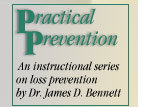

Article 1: LPS Overview | Article 2: Loss Investigations | Article 3: Loss Prevention Observations
| James D. Bennett, Ph.D., is an international loss prevention consultant for the petroleum, mining, manufacturing, and construction industries, as well as government organizations. He received a doctorate from The Pennsylvania State University where he was a faculty member in the Department of Mineral Engineering from 1974-1986, and Director of Earth and Mineral Sciences Continuing Education. Dr. Bennett was an executive with Exxon's El Cerrejon surface coal mine project in Colombia from 1986 - 1987. Since 1987 he has been in private practice as president of Loss Prevention Systems. Today, more than 60,000 employees and contractors use the Loss Prevention System in 65 countries located throughout North, South and Central America, Europe, Africa, and Asia Pacific. The system is also used in the Caribbean. Dr. Bennett is a U.S. Army veteran with service in Europe and Vietnam. |
Introduction
The purpose of this series of articles is to describe briefly how the Loss Prevention System (LPS), can lower workers' compensation costs. The cost reduction methods described in these articles are tried and proven steps taken by industrial companies over the past 28 years. This first article provides a general overview of LPS and explains the fundamental principles on which this system is based. Future articles will describe more specifically how to develop and use six LPS tools: safe performance self-assessments, job safety analyses, loss prevention observations, near-loss and loss investigations, and stewardship. Collectively, these tools can lower workers' compensation costs, regardless of the industry or size of the company.
Currently, there are 60,000 employees and contractors in 65 countries using the Loss Prevention System. LPS has saved companies millions of dollars in workers' compensation costs, equipment and property damage, product quality incidents, regulatory assessments, and operational inefficiencies -- large companies, as well as small companies, and in such diverse industries as manufacturing, construction, mining, petroleum, chemicals, etc.
So how can you lower the cost of your workers' compensation? -- Through the daily use of your own, custom-made LPS.
What is LPS?
LPS is a business philosophy of how to run a profitable business, as well as a management system designed to reduce losses, or unplanned costs, associated with personal injuries, equipment and property damage, product quality incidents, regulatory assessments, and operational inefficiencies. Each of these events has an adverse cost associated with it. LPS can systematically reduce or eliminate the dollars expended for each of these incidents. This series of articles focuses on the workers' compensation costs that are associated with personal injuries.
Business Philosophy/Management System
It sounds like a fancy phrase but this business philosophy has four principles that are essential to the success of LPS. Adherence to these principles is an absolute prerequisite for lowering workers' compensation costs.
Systematic
LPS follows a standard set of operating guidelines day in and out. Here are just a few of these guidelines as they apply to the previously-mentioned LPS tools or activities.
A job safety analysis is both a technique and a tool. As a technique, a JSA reviews a work process, identifies potential hazards, and recommends procedures to perform the job safely. This technique produces a JSA tool that briefly outlines the proper way to perform a job. JSAs are used as a proactive hazard identification and risk assessment tool, in preparation and reference for loss prevention observations, in task and refresher training, and as a monitoring and control tool for construction and maintenance activities.
For an organization to eliminate undesirable work practices and workplace hazards leading to losses, there are two fundamental principles that must be followed. First, provide positive reinforcement for correct work behaviors and practices consistent with the organization's work standards. Second, identify and eliminate deviations from these work standards. Industrial research has shown that these principles applied together are far more effective than either one alone.
Custom Made
Although every LPS operates under the same fundamental principles and within a general framework, each LPS is custom made to match the unique needs of that organization. This tailoring to an operation must be done to ensure that LPS reflects the specific circumstances, characteristics, resources, and potential hazards of a particular workplace.
What's Next?
Future articles will describe how to develop and use six key LPS tools to reduce workers' compensation costs: safe performance self-assessments, job safety analyses, loss prevention observations, near-loss and loss investigations, and stewardship.
Copyright © 2001 Dr. James D. Bennett, Loss Prevention Systems
About KARE | Agent Locator | Regulatory News | Newsletter Archive
Policyholders | Agents | Why Choose KARE? | Contact Us | Home
Copyright © 2001-2002 Kentucky Association of Responsible Employers. All rights reserved.
Questions or comments about this site? We welcome your feedback.
Experiencing technical difficulties? Contact our webmaster.
Site created & maintained by McBride Design


